Input interpretation

NH_4Cl ammonium chloride + NaNO_2 sodium nitrite ⟶ H_2O water + NaCl sodium chloride + N_2 nitrogen
Balanced equation
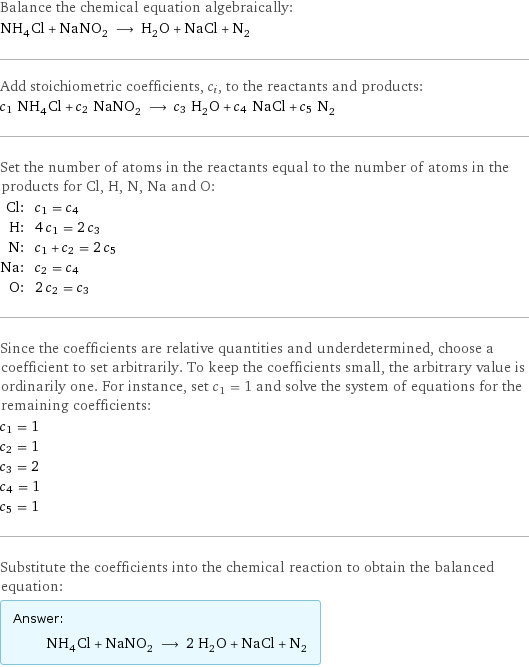
Balance the chemical equation algebraically: NH_4Cl + NaNO_2 ⟶ H_2O + NaCl + N_2 Add stoichiometric coefficients, c_i, to the reactants and products: c_1 NH_4Cl + c_2 NaNO_2 ⟶ c_3 H_2O + c_4 NaCl + c_5 N_2 Set the number of atoms in the reactants equal to the number of atoms in the products for Cl, H, N, Na and O: Cl: | c_1 = c_4 H: | 4 c_1 = 2 c_3 N: | c_1 + c_2 = 2 c_5 Na: | c_2 = c_4 O: | 2 c_2 = c_3 Since the coefficients are relative quantities and underdetermined, choose a coefficient to set arbitrarily. To keep the coefficients small, the arbitrary value is ordinarily one. For instance, set c_1 = 1 and solve the system of equations for the remaining coefficients: c_1 = 1 c_2 = 1 c_3 = 2 c_4 = 1 c_5 = 1 Substitute the coefficients into the chemical reaction to obtain the balanced equation: Answer: | | NH_4Cl + NaNO_2 ⟶ 2 H_2O + NaCl + N_2
Structures
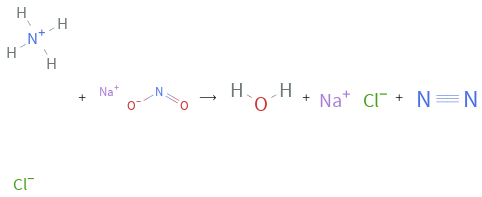
+ ⟶ + +
Names

ammonium chloride + sodium nitrite ⟶ water + sodium chloride + nitrogen
Reaction thermodynamics
Enthalpy
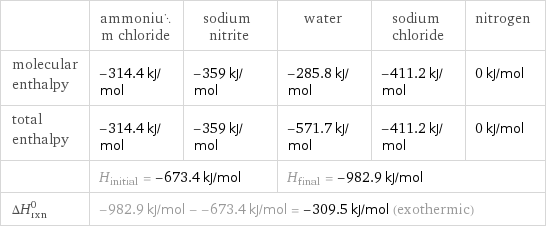
| ammonium chloride | sodium nitrite | water | sodium chloride | nitrogen molecular enthalpy | -314.4 kJ/mol | -359 kJ/mol | -285.8 kJ/mol | -411.2 kJ/mol | 0 kJ/mol total enthalpy | -314.4 kJ/mol | -359 kJ/mol | -571.7 kJ/mol | -411.2 kJ/mol | 0 kJ/mol | H_initial = -673.4 kJ/mol | | H_final = -982.9 kJ/mol | | ΔH_rxn^0 | -982.9 kJ/mol - -673.4 kJ/mol = -309.5 kJ/mol (exothermic) | | | |
Gibbs free energy

| ammonium chloride | sodium nitrite | water | sodium chloride | nitrogen molecular free energy | -202.9 kJ/mol | -284.6 kJ/mol | -237.1 kJ/mol | -384.1 kJ/mol | 0 kJ/mol total free energy | -202.9 kJ/mol | -284.6 kJ/mol | -474.2 kJ/mol | -384.1 kJ/mol | 0 kJ/mol | G_initial = -487.5 kJ/mol | | G_final = -858.3 kJ/mol | | ΔG_rxn^0 | -858.3 kJ/mol - -487.5 kJ/mol = -370.8 kJ/mol (exergonic) | | | |
Equilibrium constant
![Construct the equilibrium constant, K, expression for: NH_4Cl + NaNO_2 ⟶ H_2O + NaCl + N_2 Plan: • Balance the chemical equation. • Determine the stoichiometric numbers. • Assemble the activity expression for each chemical species. • Use the activity expressions to build the equilibrium constant expression. Write the balanced chemical equation: NH_4Cl + NaNO_2 ⟶ 2 H_2O + NaCl + N_2 Assign stoichiometric numbers, ν_i, using the stoichiometric coefficients, c_i, from the balanced chemical equation in the following manner: ν_i = -c_i for reactants and ν_i = c_i for products: chemical species | c_i | ν_i NH_4Cl | 1 | -1 NaNO_2 | 1 | -1 H_2O | 2 | 2 NaCl | 1 | 1 N_2 | 1 | 1 Assemble the activity expressions accounting for the state of matter and ν_i: chemical species | c_i | ν_i | activity expression NH_4Cl | 1 | -1 | ([NH4Cl])^(-1) NaNO_2 | 1 | -1 | ([NaNO2])^(-1) H_2O | 2 | 2 | ([H2O])^2 NaCl | 1 | 1 | [NaCl] N_2 | 1 | 1 | [N2] The equilibrium constant symbol in the concentration basis is: K_c Mulitply the activity expressions to arrive at the K_c expression: Answer: | | K_c = ([NH4Cl])^(-1) ([NaNO2])^(-1) ([H2O])^2 [NaCl] [N2] = (([H2O])^2 [NaCl] [N2])/([NH4Cl] [NaNO2])](../image_source/eebb207f07fe7bdc203678f2d19fc19c.png)
Construct the equilibrium constant, K, expression for: NH_4Cl + NaNO_2 ⟶ H_2O + NaCl + N_2 Plan: • Balance the chemical equation. • Determine the stoichiometric numbers. • Assemble the activity expression for each chemical species. • Use the activity expressions to build the equilibrium constant expression. Write the balanced chemical equation: NH_4Cl + NaNO_2 ⟶ 2 H_2O + NaCl + N_2 Assign stoichiometric numbers, ν_i, using the stoichiometric coefficients, c_i, from the balanced chemical equation in the following manner: ν_i = -c_i for reactants and ν_i = c_i for products: chemical species | c_i | ν_i NH_4Cl | 1 | -1 NaNO_2 | 1 | -1 H_2O | 2 | 2 NaCl | 1 | 1 N_2 | 1 | 1 Assemble the activity expressions accounting for the state of matter and ν_i: chemical species | c_i | ν_i | activity expression NH_4Cl | 1 | -1 | ([NH4Cl])^(-1) NaNO_2 | 1 | -1 | ([NaNO2])^(-1) H_2O | 2 | 2 | ([H2O])^2 NaCl | 1 | 1 | [NaCl] N_2 | 1 | 1 | [N2] The equilibrium constant symbol in the concentration basis is: K_c Mulitply the activity expressions to arrive at the K_c expression: Answer: | | K_c = ([NH4Cl])^(-1) ([NaNO2])^(-1) ([H2O])^2 [NaCl] [N2] = (([H2O])^2 [NaCl] [N2])/([NH4Cl] [NaNO2])
Rate of reaction
![Construct the rate of reaction expression for: NH_4Cl + NaNO_2 ⟶ H_2O + NaCl + N_2 Plan: • Balance the chemical equation. • Determine the stoichiometric numbers. • Assemble the rate term for each chemical species. • Write the rate of reaction expression. Write the balanced chemical equation: NH_4Cl + NaNO_2 ⟶ 2 H_2O + NaCl + N_2 Assign stoichiometric numbers, ν_i, using the stoichiometric coefficients, c_i, from the balanced chemical equation in the following manner: ν_i = -c_i for reactants and ν_i = c_i for products: chemical species | c_i | ν_i NH_4Cl | 1 | -1 NaNO_2 | 1 | -1 H_2O | 2 | 2 NaCl | 1 | 1 N_2 | 1 | 1 The rate term for each chemical species, B_i, is 1/ν_i(Δ[B_i])/(Δt) where [B_i] is the amount concentration and t is time: chemical species | c_i | ν_i | rate term NH_4Cl | 1 | -1 | -(Δ[NH4Cl])/(Δt) NaNO_2 | 1 | -1 | -(Δ[NaNO2])/(Δt) H_2O | 2 | 2 | 1/2 (Δ[H2O])/(Δt) NaCl | 1 | 1 | (Δ[NaCl])/(Δt) N_2 | 1 | 1 | (Δ[N2])/(Δt) (for infinitesimal rate of change, replace Δ with d) Set the rate terms equal to each other to arrive at the rate expression: Answer: | | rate = -(Δ[NH4Cl])/(Δt) = -(Δ[NaNO2])/(Δt) = 1/2 (Δ[H2O])/(Δt) = (Δ[NaCl])/(Δt) = (Δ[N2])/(Δt) (assuming constant volume and no accumulation of intermediates or side products)](../image_source/34c5458d3a709818a8442e964f6cef44.png)
Construct the rate of reaction expression for: NH_4Cl + NaNO_2 ⟶ H_2O + NaCl + N_2 Plan: • Balance the chemical equation. • Determine the stoichiometric numbers. • Assemble the rate term for each chemical species. • Write the rate of reaction expression. Write the balanced chemical equation: NH_4Cl + NaNO_2 ⟶ 2 H_2O + NaCl + N_2 Assign stoichiometric numbers, ν_i, using the stoichiometric coefficients, c_i, from the balanced chemical equation in the following manner: ν_i = -c_i for reactants and ν_i = c_i for products: chemical species | c_i | ν_i NH_4Cl | 1 | -1 NaNO_2 | 1 | -1 H_2O | 2 | 2 NaCl | 1 | 1 N_2 | 1 | 1 The rate term for each chemical species, B_i, is 1/ν_i(Δ[B_i])/(Δt) where [B_i] is the amount concentration and t is time: chemical species | c_i | ν_i | rate term NH_4Cl | 1 | -1 | -(Δ[NH4Cl])/(Δt) NaNO_2 | 1 | -1 | -(Δ[NaNO2])/(Δt) H_2O | 2 | 2 | 1/2 (Δ[H2O])/(Δt) NaCl | 1 | 1 | (Δ[NaCl])/(Δt) N_2 | 1 | 1 | (Δ[N2])/(Δt) (for infinitesimal rate of change, replace Δ with d) Set the rate terms equal to each other to arrive at the rate expression: Answer: | | rate = -(Δ[NH4Cl])/(Δt) = -(Δ[NaNO2])/(Δt) = 1/2 (Δ[H2O])/(Δt) = (Δ[NaCl])/(Δt) = (Δ[N2])/(Δt) (assuming constant volume and no accumulation of intermediates or side products)
Chemical names and formulas
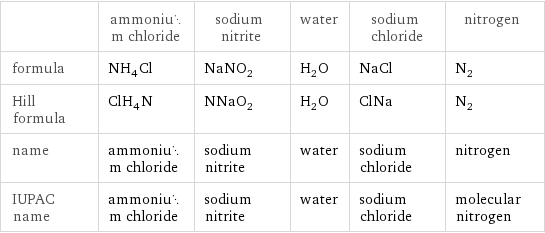
| ammonium chloride | sodium nitrite | water | sodium chloride | nitrogen formula | NH_4Cl | NaNO_2 | H_2O | NaCl | N_2 Hill formula | ClH_4N | NNaO_2 | H_2O | ClNa | N_2 name | ammonium chloride | sodium nitrite | water | sodium chloride | nitrogen IUPAC name | ammonium chloride | sodium nitrite | water | sodium chloride | molecular nitrogen
Substance properties
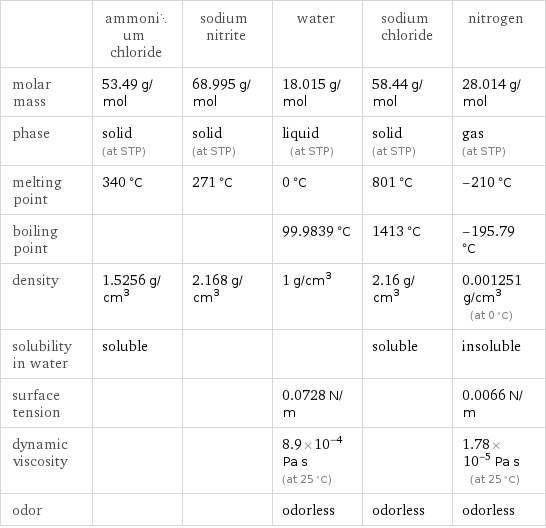
| ammonium chloride | sodium nitrite | water | sodium chloride | nitrogen molar mass | 53.49 g/mol | 68.995 g/mol | 18.015 g/mol | 58.44 g/mol | 28.014 g/mol phase | solid (at STP) | solid (at STP) | liquid (at STP) | solid (at STP) | gas (at STP) melting point | 340 °C | 271 °C | 0 °C | 801 °C | -210 °C boiling point | | | 99.9839 °C | 1413 °C | -195.79 °C density | 1.5256 g/cm^3 | 2.168 g/cm^3 | 1 g/cm^3 | 2.16 g/cm^3 | 0.001251 g/cm^3 (at 0 °C) solubility in water | soluble | | | soluble | insoluble surface tension | | | 0.0728 N/m | | 0.0066 N/m dynamic viscosity | | | 8.9×10^-4 Pa s (at 25 °C) | | 1.78×10^-5 Pa s (at 25 °C) odor | | | odorless | odorless | odorless
Units
